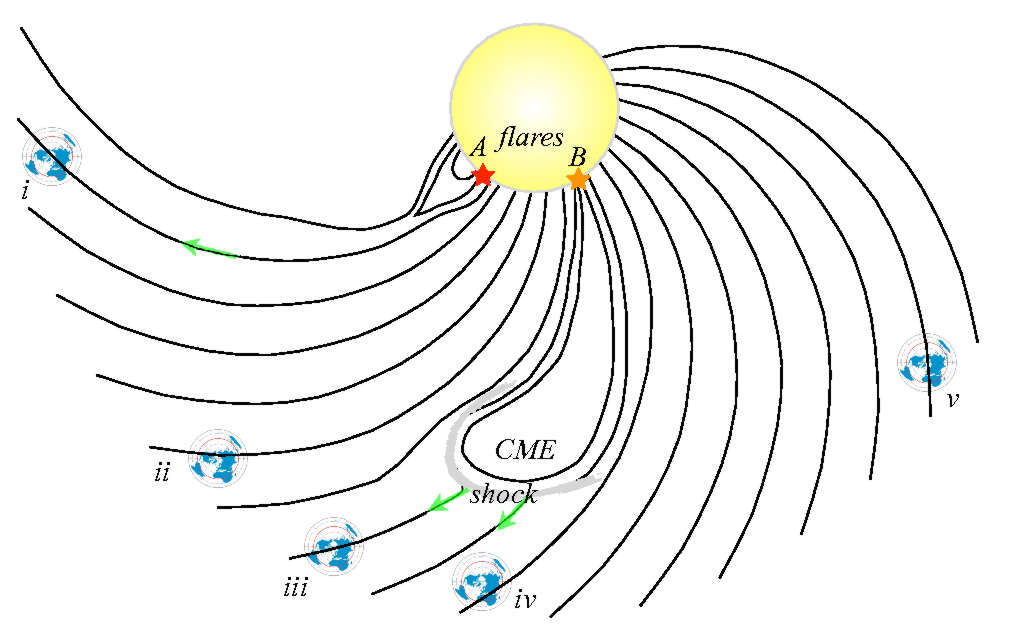
| MadSci Network: Astronomy |
It all depends on whether Venus is on the way of the solar flare. Solar flares impact Earth only when they occur on the side of the sun facing Earth. There are various kinds of emissions produced in a solar explosion, but the movie does not make a difference between all those kinds of solar emissions. Solar explosions like coronal mass ejections (CMEs) travel in one direction, and they hit the Earth if the Earth happens to be on the way. High energy particles emitted from the Sun follow CMEs. Both the CMEs and the high energy particles follow the magnetic field lines of the Sun because they are made of charged particles. If those magnetic field lines intersect the Earth, they will hit the Earth. Solar flares are light. Therefore it is more likely that they reach the Earth because light travels mostly unimpeded through space. CMEs are particles and magnetic fields. The image below, taken from the article Estimating the frequency of extremely energetic solar events, based on solar, stellar, lunar, and terrestrial records by C. J. Schrijver and coauthors, to be published in Journal of Geophysical Research, shows various situations that can happen to a planet after an explosion on the solar surface.

The curved lines represent magnetic field lines. Those lines trace the direction of the solar magnetic field when there are no solar expolsions. If an explosion happens at point A of the solar surface, it may never reach any planet at all because the magnetic field lines form a closed loop that will return the emitted particles to the Sun. Only those particles that travel outside the loop may reach the planet in position i. If a CME is emitted at point B, it will carry magnetic field and particles producing a shock. A shock is like a bulldozer blade of matter moving at high speed and sweeping gas and magnetic field in front of it. In this case a planet at positions ii or iv will receive a moderate disruption of its own magnetic field, if it has any, while a planet at position iii will certainly be hit with full force by the CME particles. A planet at position v will have no disruption at all even if it stands right in front of the point where the flare was produced.
Venus is certainly hit by all those kinds of emissions, but only if the planet happens to be in the right direction. The impact on Venus will be stronger than on Earth because Venus, like Mars, has no magnetic field of its own. Earth's magnetic field has shielded its surface from the high energy particles and coronal mass ejections because those particles, having electric charge, are deflected by magnetic fields. Solar flares on the other hand are made of light, which passes through magnetic fields and much of the atmosphere. In any case, there is no evidence that a life threatening solar eruption has happened. The Sun happens to be a relatively stable solar. Other stars are much more violent than the Sun. The largest solar storm on record happened on August 28, 1859, when numerous sunspots and solar flares where observed on the Sun. Seventeen hours later a second CME hit the Earth. The second CME reached Earth so quickly because the first CME had cleared the solar magnetic field. On September 1 and 2, aurorae produced by the high energy particles were seen around the World even at latitudes as low as the Caribbean and were so bright that newspapers could be read at night. Telegraphs were disrupted and even shocked operators because of the currents produced by the movement of magnetic field lines. The flares and its connection with the aurorae and telegraph disruptions were observed by British astronomer Richard C. Carrington. Aurorae sightings at latitudes as low as Mexico had been observed in the XVIII century, but there were no observations of solar flares at the time. Geologists have been trying to find evidence of large solar storms by measuring radioisotopes or chemical compounds that could be produced by high energy particles and be deposited in ice cores, but thus far there is no reliable indicator of past solar storm in the geological history of Earth. At least we know that a solar storm much larger than the Carrington event should produce sunspots so large that they should be visible to the naked eye, and there are no historical records of such an event in several millenia. Therefore it is difficult to imagine a solar flare as big as the one in the movie.
Greetings
Vladimir Escalante Ram�rez
Try the links in the MadSci Library for more information on Astronomy.